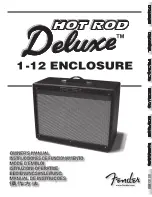
2
English
jewelry, or long hair can be caught in moving parts.
j.
Do not overreach.
Keep proper footing and
balance at all times. Proper footing and balance
enables better control of the tool in unexpected
situations.
k.
Do not use on a ladder or unstable support.
Stable footing on a solid surface enables better
control of the tool in unexpected situations.
4. TOOL USE AND CARE
a.
Do not exceed the pressure rating of any
component in the system.
b.
Protect material lines and air lines from
damage or puncture.
Keep hose and power
cord away from sharp objects, chemical spills, oil,
solvents, and wet floors.
c.
Check hoses for weak or worn condition before
each use, making certain all connections are
secure.
Do not use if defect is found.
d.
Purchase a new hose or notify an authorized
service center for examination or repair.
e.
Release all pressures within the system slowly.
Dust and debris may be harmful.
f.
Store idle tools out of the reach of children and
other untrained persons.
Tools are dangerous in
the hands of untrained users.
g.
Maintain tools with care.
Follow maintenance
instructions. Properly maintained tools are easier
to control.
h.
Check for misalignment or binding of moving
parts, breakage of parts, and any other
condition that may affect the operation of the
tool.
If damaged, have the tool serviced before
using.
i.
Many accidents are caused by poorly
maintained tools.
j.
Never point any tool toward yourself or others.
k.
Keep the exterior of the air station dry, clean,
and free from oil and grease.
Always use a
clean cloth when cleaning. Never use brake fluids,
gasoline, petroleum-based products, or any strong
solvents to clean the unit. Following this rule will
reduce the risk of deterioration of the enclosure
plastic.
5. SERVICE
a.
Tool service must be performed only
by qualified repair personnel.
Service or
maintenance performed by unqualified personnel
may result in a risk of injury.
b.
Disconnect power supply, open drain valve to
decompress tank and allow water to drain, and
allow air compressor to become cool to the
touch before servicing.
Turn pressure regulator
knob fully counterclockwise after shutting off
compressor.
c.
When servicing a tool, use only identical
replacement parts.
Follow instructions in the
Maintenance section of this manual. Use of
unauthorized parts or failure to follow Maintenance
instructions may create a risk of injury.
SPECIAL SAFETY RULES
1.
Know your air station.
Read operation manual
carefully. Learn its applications and limitations, as well
as the specific potential hazards related to this tool.
Following this rule will reduce the risk of electric shock,
fire, or serious injury.
2.
Drain tank of moisture after use each day.
If unit will
not be used for a while, it is best to leave drain valve
open until such time as it is to be used. This will allow
moisture to completely drain out and help prevent
corrosion on the inside of tank.
3.
Risk of fire or explosion.
Do not spray flammable
liquid in a confined area. Spray area must be well
ventilated. Do not smoke while spraying or spray
where spark or flame is present. Keep stations as far
from the spraying area as possible, at least 4.6 m from
the spraying area and all explosive vapors.
4.
Risk of bursting.
Do not adjust regulator to result
in output pressure greater than marked maximum
pressure of attachment and/or the item being inflated.
Never use at pressure greater than 9.3 bar.
5.
Use an air pressure gauge periodically while
inflating an item to check the air pressure.
6.
If connected to a circuit protected by fuses, use
time-delay fuses with this product.
7.
To reduce the risk of electric shock, do not expose
to rain.
Store indoors.
8.
Inspect tank yearly for rust, pin holes, or other
imperfections that could cause it to become
unsafe.
Never weld or drill holes in the air tank.
9.
Make sure the hose is free of obstructions or
snags.
Entangled or snarled hoses can cause loss of
balance or footing and may become damaged.
10.
Use the air station only for its intended use.
Do
not alter or modify the unit from the original design or
function.
11.
Always be aware that misuse and improper
handling of this tool can cause injury to yourself
and others.
12.
Do not place over 114 kg on the work seat.
Doing so
could result in damage to the product.
13.
Never step or stand on the work seat.
Following this
rule will reduce the risk of serious personal injury.
14.
To reduce the risk of personal injury, do not use
work seat as a step or platform.
15.
Never leave a tool unattended with the coil air hose
Содержание ERC1512
Страница 1: ...ERC1512 OWNER S OPERATING MANUAL ORIGINAL INSTRUCTIONS ...
Страница 2: ...Fig 1 1 2 Fig 2 17 16 12 13 20 15 14 11 19 18 E 6 9 10 3 4 8 5 7 ...
Страница 3: ...10 A 14 Fig 6 Fig 9 Fig 8 Fig 4 Fig 5 16 5 8 3 4 18 Fig 7 15 Fig 3 ...
Страница 4: ...Fig 12 Fig 11 8 5 3 4 Fig 13 6 Fig 10 9 21 11 22 ...

































